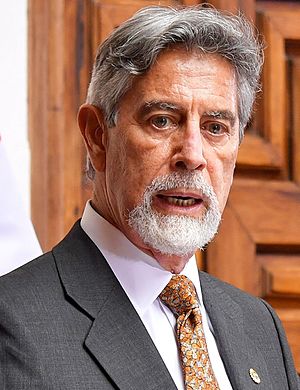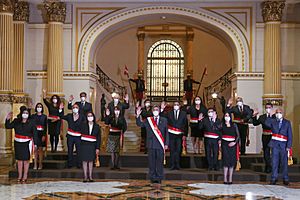Francisco Sagasti facts for kids
Quick facts for kids
Francisco Sagasti
|
|
|---|---|

Sagasti in 2020
|
|
| 62nd President of Peru | |
| In office 17 November 2020 – 28 July 2021 |
|
| Prime Minister | Violeta Bermúdez |
| Vice President | First Vice President Vacant Second Vice President Vacant |
| Preceded by | Manuel Merino |
| Succeeded by | Pedro Castillo |
| President of Congress | |
| In office 16 November 2020 – 17 November 2020 |
|
| Vice President | 1st Vice President Mirtha Vásquez 2nd Vice President Luis Roel 3rd Vice President Matilde Fernández |
| Preceded by | Manuel Merino Luis Valdez Farías (interim) Rocío Silva-Santisteban (acting) |
| Succeeded by | Mirtha Vásquez (acting) |
| Parliamentary Spokesperson of the Purple Party |
|
| In office 16 March 2020 – 16 November 2020 |
|
| Preceded by | Position established |
| Succeeded by | Daniel Olivares |
| Member of Congress | |
| In office 16 March 2020 – 17 November 2020 |
|
| Constituency | Lima |
| Personal details | |
| Born | 10 October 1944 Lima, Peru |
| Political party | Purple Party (2016–present) |
| Other political affiliations |
|
| Spouse |
Silvia Cristina de las Mercedes Charpentier Brenes
(m. 1993; div. 2005) |
| Children |
|
| Parents |
|
| Alma mater |
|
| Signature | |
Francisco Rafael Sagasti Hochhausler (born October 10, 1944) is a Peruvian engineer, professor, and politician. He served as the President of Peru for a short time, from November 2020 to July 2021.
Before becoming president, Sagasti worked as an advisor for important groups like the World Bank and the World Economic Forum. He helped countries with their economic development. In 2016, he co-founded the Purple Party, a political party in Peru that believes in finding a middle ground in politics. In 2020, he was elected to the Congress of Peru.
His path to the presidency was unusual. In November 2020, President Martín Vizcarra was removed from office by Congress. The head of Congress, Manuel Merino, then became president. Many people in Peru were angry about this change and believed it was an illegal power grab. Large protests broke out across the country. After only five days, Merino resigned.
Congress then chose Sagasti to be its new leader. Because of the rules of succession in Peru, this made him the next president. He took office on November 17, 2020, becoming the fourth president in a single five-year term. His main job was to lead the country through this difficult period until the next election in 2021.
Contents
Early Life and Schooling
Francisco Sagasti was born in Lima, Peru. His grandfather, Francisco Sagasti Saldaña, was a national hero who fought in the Battle of Tarapacá. His mother's family came from Austria.
Sagasti was a very good student. He studied industrial engineering at the National University of Engineering in Peru. He then went to the United States for more education. He earned a master's degree from Pennsylvania State University and a PhD from the University of Pennsylvania.
Career Before Politics
Working for the Government and the World
In the 1970s, Sagasti worked for the Peruvian government. He gave advice on how to improve industry and technology in the country.
Later, he worked for international organizations. From 1987 to 1990, he was a high-level advisor at the World Bank. The World Bank helps countries around the world with money and advice to reduce poverty. He also worked with the United Nations on science and technology.
Return to Peru
In 1992, after a political crisis in Peru, Sagasti left his job at the World Bank and returned home. He wanted to help strengthen democracy in his country. He was critical of the government of President Alberto Fujimori, which he felt was becoming too powerful.
In 1996, Sagasti was taken hostage during the Japanese embassy hostage crisis. A revolutionary group took over the Japanese ambassador's house during a party. Sagasti was held for a few days before being released.
Political Career
In 2016, Sagasti helped create the Purple Party. The party's goal was to be a centrist option, meaning it didn't lean too far to the political left or right.
In January 2020, he was elected to the Congress of the Republic of Peru. When Congress voted to remove President Martín Vizcarra, Sagasti voted against it. He believed the president should be investigated, but not removed from office in that way.
The removal of Vizcarra led to massive protests. The new president, Manuel Merino, resigned after less than a week. The country was in a crisis, and it needed a leader that people could trust. Congress chose Sagasti to lead them, which automatically made him the new President of Peru.
Presidency (2020–2021)
Sagasti called his government a "transitional and emergency government." He knew his time as president would be short, so he focused on four main goals:
- Fighting the COVID-19 pandemic and getting vaccines for the country.
- Fighting corruption in the government.
- Keeping the economy stable.
- Improving education, especially in rural areas.
Many countries, including the United States and the United Kingdom, supported his presidency. One of his first major actions was to change the leadership of the National Police because of how they responded to the protests.
His government successfully managed the purchase of millions of COVID-19 vaccines. He also made sure the 2021 general elections happened on schedule, which was a very important step for Peru's democracy. He finished his term on July 28, 2021, and handed over power to the newly elected president, Pedro Castillo.
Beliefs and Ideas
Sagasti calls himself a centrist. He has said, "I don't think you have to destroy everything to create new things... That is what makes me a center person." He believes in making changes through reform rather than revolution.
He supports removing special legal protections for members of Congress, so that anyone who breaks the law can be held accountable. He also supports equal rights for all couples. On education, he believes that universities should have high standards to make sure students get a quality education.
Personal Life
From 1993 to 2005, Sagasti was married to Silvia Charpentier Brenes, an economist and politician from Costa Rica. They have one daughter. Through his marriage, Sagasti also became a citizen of Costa Rica.
Besides his work in politics and engineering, Sagasti is also creative. He has written lyrics and music, and in 2016, a CD was released called Mónica interpreta a Sagasti (Mónica sings Sagasti).
See also
 In Spanish: Francisco Sagasti para niños
In Spanish: Francisco Sagasti para niños


